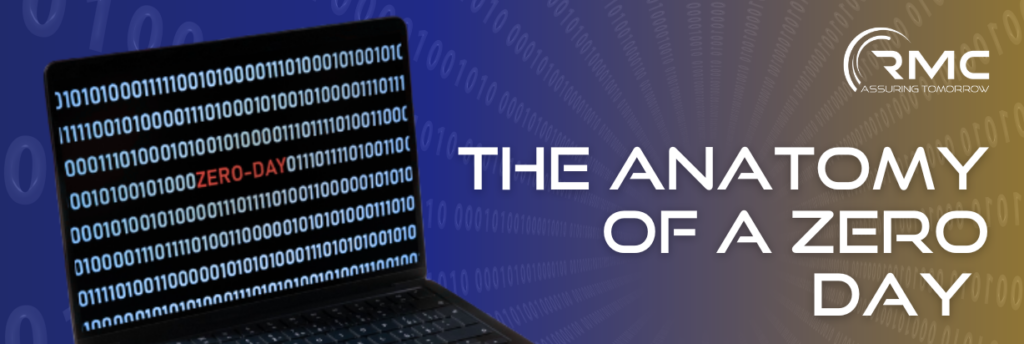Zero-day vulnerabilities occupy a unique and critical space in cybersecurity. They represent flaws in software, hardware, or firmware that remain unknown to the vendor and, therefore, unpatched. These vulnerabilities – often associated with remote access, data breaches, or full system compromise – offer attackers a fleeting but dangerous window of opportunity.
At RMC, we’ve encountered zero-days across industries like energy utilities, robotics, and telecommunications. Our work gives us deep insight into these vulnerabilities, their exploitation, and mitigation strategies.
What Defines a Zero-Day?
A zero-day vulnerability – commonly reserved to describe the most critical flaws – allows attackers to bypass security measures, gaining unauthorized access or disclosing sensitive information. The term “zero-day” highlights the urgency: the vendor has zero days to respond before the vulnerability is exploited.
Attackers leveraging zero-days can range from lone hackers to nation-state actors. Their motivations span financial gain, corporate espionage, and even sabotage. On the other side, defenders like ethical hackers and security researchers race to discover and address these flaws before they cause irreparable damage. The critical period between discovery and mitigation is often referred to as the “zero-day window.”
The Lifecycle of a Zero-Day Exploit
To understand the threat, let’s dissect the anatomy of a zero-day – from discovery to remediation:
- Discovery: Zero-days often come to light through rigorous analysis of systems and code. Whether uncovered by dedicated security researchers, hackers, or nation-states, the initial identification of a zero-day is always a pivotal moment. Some vulnerabilities are identified through advanced static and dynamic analysis, while others emerge through penetration testing.
- Proof of Concept (PoC): After discovery, a Proof of Concept is often developed to demonstrate the exploitability of the vulnerability. While responsible actors often disclose PoCs to vendors or share them in closed research communities, some PoCs are released publicly or sold on underground markets, amplifying their threat potential.
- Exploitation: When a zero-day is weaponized, attackers craft payloads tailored to exploit the vulnerability. For instance, vulnerabilities like Broken Access Control might allow unauthorized access to sensitive data, while Remote Code Execution (RCE) flaws could enable attackers to seize control of entire systems.
- Detection: Detecting zero-day exploits in the wild is an ongoing challenge. Advanced Endpoint Detection and Response (EDR) tools and behavioral analytics are often the first lines of defense, spotting anomalies or malicious activity that could indicate exploitation.
- Disclosure: Ethical hackers and security researchers play a critical role in reporting zero-days to vendors, initiating the patching process. Disclosure is a sensitive step, balancing the urgency of fixing the flaw against the risks of publicizing its existence.
- Mitigation: Before a vendor releases a patch, organizations must act to contain the threat. Isolating affected systems, restricting access, or disabling vulnerable functionalities are common mitigation strategies during this window.
- Remediation: Finally, vendors issue patches or updates to resolve the vulnerability, allowing organizations to restore their systems to a secure state.
Zero-Day Threats in Practice
Zero-day vulnerabilities manifest differently across industries. At RMC, we’ve observed:
In web applications, Broken Access Control vulnerabilities are prevalent, often enabling attackers to escalate privileges or expose sensitive user data. These flaws, while common, are particularly impactful in critical sectors like energy utilities.
Embedded systems, such as those in robotics or telecommunications, frequently suffer from RCE vulnerabilities. These exploits allow attackers to fully compromise devices, highlighting the unique risks faced by industries relying on interconnected, smart technologies.
RMC’s Approach to Zero-Day Discovery and Defense
Given these diverse risks, a structured approach is essential. At RMC, our approach to zero-days is rooted in technical rigor and actionable outcomes. Our work goes beyond identifying vulnerabilities to ensure our clients understand the full scope of their risks and how to address them effectively.
For instance, we specialize in PoC testing that demonstrates how a zero-day can be exploited within a client’s environment. This hands-on approach helps stakeholders grasp the severity of the threat and informs their mitigation strategies. Additionally, our zero-day threat simulations enable organizations to visualize the impact of these vulnerabilities, offering invaluable insights into potential breaches and defenses.
Our commitment extends to guiding clients in implementing robust, secure architectures. By advocating for principles like zero-trust and layered defenses, we help organizations build environments resilient to both known and unknown threats.
Building Resilience Against Zero-Days
Combatting zero-days requires proactive and layered defenses. Organizations can strengthen their cybersecurity posture in the following ways:
- Vigilant Patching: While zero-days are unpatched by definition, maintaining up-to-date systems minimizes other exploitable vulnerabilities, reducing attack vectors.
- Comprehensive Testing: Regular pen tests and code reviews – both static and dynamic – are critical to uncovering latent vulnerabilities before attackers do.
- Behavioral Monitoring: Advanced tools like EDR provide early warnings by identifying unusual activity patterns.
- Zero-Trust Principles: Limiting access to only what is necessary and continuously verifying user and system activities create significant barriers to exploitation.
- Incident Preparedness: A robust incident response plan ensures that when breaches occur, teams can act swiftly to contain and mitigate damage.
Upholding Confidentiality and Trust
Throughout our engagements, RMC prioritizes client confidentiality. By anonymizing data and aggregating findings, we share industry-wide insights without identifying individual organizations. Moreover, we ensure no vulnerabilities are disclosed – even in anonymized forms – until they are fully remediated, reinforcing the trust our clients place in us.
Why Choose RMC?
Zero-days epitomize the unpredictable nature of cybersecurity threats. With RMC’s expertise, organizations gain protection and confidence. Our technical depth, combined with a steadfast commitment to confidentiality and proactive defense, positions us as a trusted partner in navigating today’s complex threat landscape.
Discover how RMC can help you uncover vulnerabilities, strengthen your defenses, and secure your organization’s future.
How can RMC help your organization?
Contact us today: [email protected]
Be sure to follow RMC on LinkedIn, and bookmark our News & Perspectives website to stay apprised of industry insights and topical advice on establishing cyber resiliency in OT environments.
